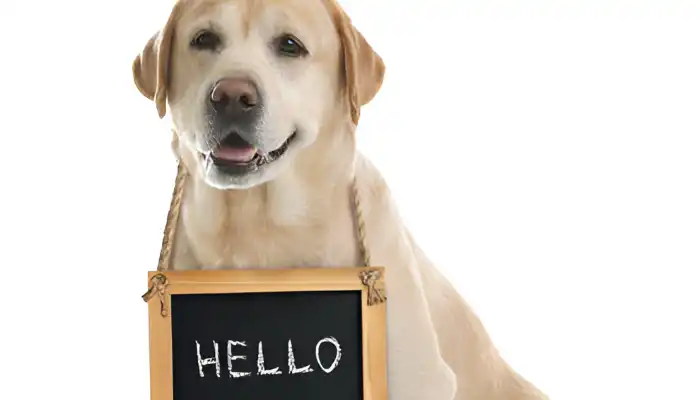What’s hello in dog language? Understanding how dogs greet us goes beyond simple gestures. Dogs communicate in the language of hello through a mix of body movements and vocalizations. From tail wags to ear positioning, their greeting can reflect a range of emotions and intentions.
In this article, we will talk about how dogs greet people and other animals through their body language and sounds. From a happy bark to a wagging tail and jumping, a dog is always ready to say “hello.” Let us assist you in translating that message through a dog translator.

How Do Dogs Say Hello?
When a dog communicates in the form of greeting, for example, barking and other friendly vocalizations, dogs say a little more than just a “hi.” If you’ve ever wondered what’s hello in dog language, you should focus on the mix of sounds a dog’s bark contains:
- Children’s Animals: Dogs, Body Parts and their Functions Wags of the tail, dog ears, and general stance of the dog will assist in determining the moods and intentions of the dogs.
- Animals Speak: Dogs Bark, cry, and other sounds can also be forms of greetings.
Pawing (Jumping) and Barking: How Dogs Say Hello
Body language is crucial for communication among dogs. Tail movement is often an indication of what the dog is feeling.
Important Signals That Dogs Use to Say ‘Hello’
What’s hello in dog language? Important signals that dogs use to say ‘hello’ reveal the fascinating ways dogs communicate their excitement and affection. From tail wags to vocalizations, understanding these signals can help you better connect with your dog.
1. Wiggle A Paw
Tail wagging is perhaps the first thing we think of when it comes to saying hello. As you may know, not all tail wags have the same meaning.
| Tail Up / Down | Significance |
|---|---|
| Drooping | The dog is calm and friendly. |
| Chopping At Fast Pace | It may indicate excitement, extreme joy, or anxiety. |
| Mid Range | It is a form of greeting, but can also mean the dog is submissive or unsure. |
| Holding Stiffly Above | This indicates the dog may be alert to or threatened by something. |
2. Dog’s Ears Positioning
Both domesticated and wild dogs utilize their ears as tools for communication. Dogs can say ‘hello’ while moving their ears into the following position:
- Ears Up Straight: Your dog is happy and seems to be attentive toward you.
- Ears Hanging Out To The Side: It’s a sign they’re relaxed and content.
- Semi-flattened ears: Dogs are likely showing signs of fear or submission.
3. Facial Expressions
Dogs are very expressive, and their faces can tell you so much during a greeting. Here’s how they express themselves:
- Relaxed Face: Greeting done softly. The dog’s mouth is slightly open, and the eyes are relaxed.
- Squinty Eyes: The dog is smiling and is happy while greeting.
- Wide Eyes: The dog is surprised or unsure.
4. Jumping Up
A lot of dogs jump to greet you. Although it may appear cute, biting is unmistakably a display of enthusiasm. It is your dog’s way of saying, “I am happy to see you.” But in adult dogs, jumping does not have to be purely for joy; at times it is also a show of dominance.
To ensure good relationship with your pet, you may want to take note of their tail movements, ear positions, and vocalizations so that you will be ready to react appropriately to their greetings.
Vocalizations: Dog Sounds for Greeting
And do not forget the sounds dogs make when asking, “What’s hello in dog language?” Most of the words you will hear include:
1. Barking
Most of the time dogs bark due to agitation, which looms across as an act of saying ‘hello.’ Tone of the bark can also greatly influence usual outcomes.
- High-Pitched Bark: They are welcoming and friendly.
- Deep, Loud Bark: This could mean excitement or impatience.
2. Whining
If a dog is particularly eager to be attended to, whining can be a sign of a greeting. Make sure to take note of their other body language because it can also signal exasperation.
3. Growling
Usually, dogs are perceived to be aggressive when they growl, but the opposite is true when a dog growls while playfully inviting a person. Low-friendly growls might show that a dog wants to play.
The audio of joy and love from a canine is the barking, whining, or growling that’s collectively called Dog Sounds for Greeting. The excitement dogs feel is expressed best through these sounds as vocal expressions of their emotions.
How Should You React When a Dog Says ‘Hello’?
Here are some steps that work for everyone if you don’t know what to do when a dog says “hello” when he sees you:
- Stay Calm: A dog can sense when you are stressed or relaxed; therefore, being calm will help him remain at peace.
- Allow the Dog to Come to You: With anxious and shy dogs, letting the dog come to you is very crucial.
- Use Gentle Touch: If petting is needed, then give gentle pats to the ears and try scratching them.
- Don’t Overwhelm: Avoid shouting and moving about too quickly as it may shock the dog.
By staying calm, allowing them to approach, and using gentle touches, you can strengthen your bond and ensure a joyful greeting.
Is Dog Greeting Behavior Different Across Cultures?
What’s hello in dog language? Different regions of the world and dog breeds can impact how a dog approaches people and how they are approached. The patterns of how dogs tend to “say hello” in different contexts are summarized below.
1. Sociable Approach In Different Dog Breeds
- Friendly Dog Breeds: These breeds will actively try to initiate contact and will usually do so by jumping up and tail wagging, which makes them lively as well. (For example, Labrador and Golden Retriever).
- Reserved Approach: The more reserved and unapproachable breeds of dogs, Shiba Inu, and Basenji will use low calm body and vocal greetings.
2. Behavioral Differences Based on Geography
- Dogs in rural areas probably do not use any formal greeting etiquette.
- Urban dogs, on the other hand, can be more lively, especially if they are used to many people or cars driving around.
Dogs’ greetings can vary based on their breed and geographical location. Understanding these regional and breed-specific differences helps us better interpret how dogs say “hello” in various contexts.
Summary Of Key Greetings In Dog Language
Lastly, here’s a concise way of marking the important parts of how dogs advance towards humans:
- Tail Wags: A remote sign of happiness or excitement.
- Positioned ears: A sign of submission or communication of mood.
- Facial Expressions: During quiet greetings, the face is relaxed. Excitement is marked by squinting eyes.
- Barking: Dominance, or impatience, is indicated through low-pitched barking while high-pitched barking shows excitement.
- Whine: Rage-in-friendliness-whine or can be used to express frustration.
- Jumping: A form of greeting that indicates excitement, dominance, or just a sweet hello.
Highlighting key signals like tail wags, ear positions, and vocalizations. These cues will permit you to establish a better connection with your dog regarding how he uniquely greets you.
What’s hello in dog language? Every dog has a different way of greeting us, such as wagging their tails, barking, and even jumping up and down. Each behavior expresses a different level of joy. Apart from joyous barking, dogs welcome us with different sounds and specific body movements.
Proper understanding of their ear position, facial expressions, and even vocal sounds enables you to better understand their greeting. The next time your dog says ‘hello’, remember these signs and you and your dog will have a stronger bond!
